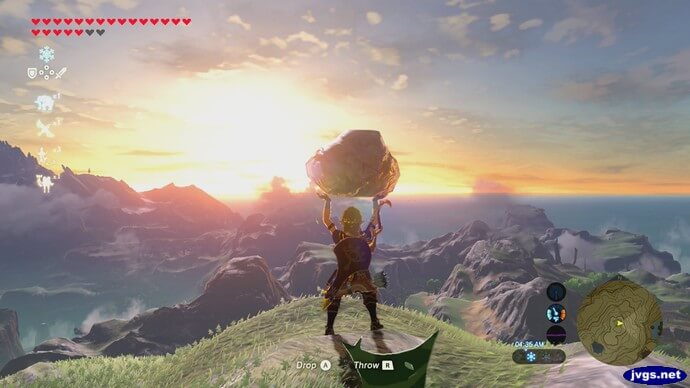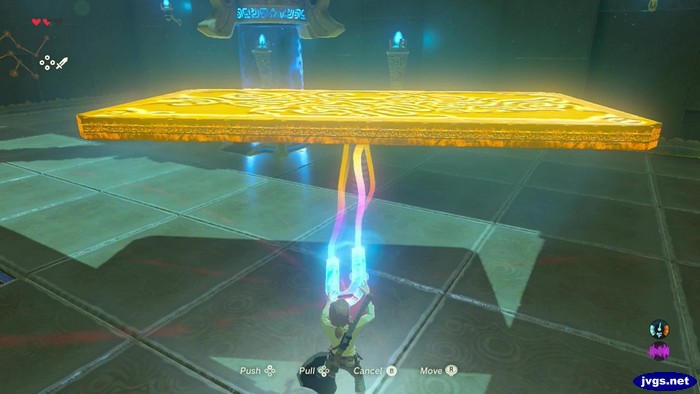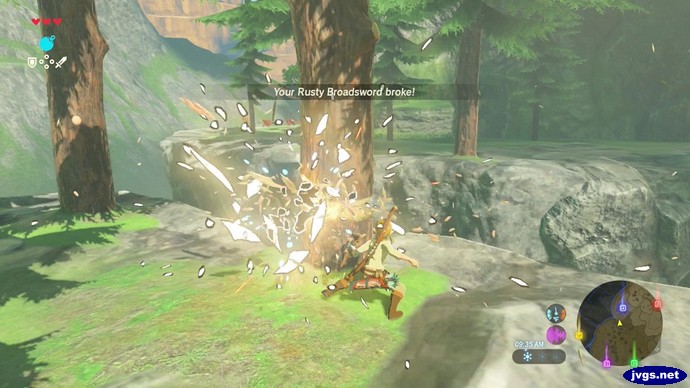Link is free to explore the vast, expansive world in The Legend of Zelda: Breath of the Wild. To call the game huge is an understatement. The world is colossal, easily dwarfing every other Zelda game by a wide margin. And that world is filled with many hidden things to find…shrines, Korok seeds, treasure chests, and much more.

#Goals
Completing shrines will be one of your first goals in the game. There are a whopping 120 of them in the game, and each one is essentially a mini-dungeon. Many of them have puzzles to be solved, some of them are combat tests, and a few even use motion controls to roll an orb around a maze (those are my least favorite).
Each shrine will yield one spirit orb upon completion, and you can trade in four spirit orbs for a new heart container or stamina vessel. Even though I preferred to stock up on heart pieces early on, I eventually discovered that stamina is more valuable. Having multiple stamina wheels allows you to climb higher, run farther, and explore easier. Fighting enemies in the overworld, for the most part, is optional. Many times, it’s better to run away…especially if you’re not stocked up on health items like food and potions.
Speaking of food, Breath of the Wild allows you to collect items you find–mushrooms, fruit, flowers, monster parts, and more–and cook them to make various dishes. Characters may tell you recipes for certain foods, and others can be learned through experimentation. Certain dishes and potions will give you abilities that last for a limited time: They may give you extra stamina, resistance to heat or cold, attack/defense boosts, and so on. Cooking up exactly what you need is very helpful ability, but it’s a tedious and time-consuming process if you’re making multiple dishes.
The first few shrines in the game give you runes, which Link can use to obtain special powers. That includes the ability to place bombs, the power of magnesis (the ability to lift and move metal items, regardless of size or weight), cryonis (the ability to make ice pillars on water), and stasis (the ability to stop time for an object and hit it repeatedly to add up its kinetic energy). These abilities are essential for completing many areas of the game, so mastering them is a necessity.

In many ways, Breath of the Wild is not your traditional Zelda game. It’s far less linear than just about any previous Zelda game, and most things can be done in any order you wish. Instead of a traditional eight dungeons, Breath of the Wild essentially has five main dungeons: Four mechanical “Divine Beasts,” and then of course Hyrule Castle at the end of the game. And even those feel nothing like the typical dungeons you’d find in a Zelda game.
There are also dozens of side quests scattered throughout the world. But sometimes the most fun comes just from exploration and experimentation. You can use your rune abilities in creative ways, and some tasks can be completed using a variety of methods. You can sneak up on wild animals to mount and tame them, and then ride them around. That ability isn’t limited to wild horses, but also other wildlife including deer, moose, and even bears! And of course, you can also set things on fire and watch the world burn.
Sword Loser
By far, my least favorite aspect of the game is the weapon system. It starts out with a cool premise: You can pick up weapons from defeated enemies, and even use defeated skeleton’s arms to bash other baddies. The problem is that the weapons you acquire are fragile. In many cases, they won’t last more than a few minutes of fighting. You may even need multiple weapons to defeat a single enemy (and not just bosses)! So you always need to be stockpiling weapons to swap out each time one of them breaks. (The same thing applies to shields and bows).

I originally thought that would just be a temporary problem. Surely, once I got the Master Sword, I’d be set for the rest of the game, right? Nope. While the Master Sword doesn’t break, it still runs out of “power” after a while, and it can’t be used while it recharges. So you’ll still need to swap in other weapons. It’s a bit of a pain.
Graphics & Sound
The graphics look great, as the game has some truly stunning landscapes. Sometimes I’d stop exploring just to watch a sunset, look at a rainbow, or watch a storm pass through the valley below me. The sound effects are also quite satisfying, from the rustling wind to thunder, birds singing, running water, and much more.
Towns, ranches, buildings, and other certain areas have background music playing…and it’s generally quite pleasant. But the audio isn’t perfect. When you’re out running around in the overworld, sound effects are typically all you’ll hear. Unlike virtually every other Zelda game ever made, there is no overworld theme. The lack of music for much of the game is quite a disappointment, especially when Zelda games normally have such great soundtracks.
Best of the Wild?
The Legend of Zelda: Breath of the Wild is clearly not a traditional Zelda game. While I miss some of those traditional Zelda elements, Breath of the Wild is an incredible game even without them. It’s an amazingly fun game that will keep you exploring for hundreds of hours. I can confidently say that it is the best Zelda game to date, and it’s also one of the best video games ever made.
I rate The Legend of Zelda: Breath of the Wild a strong…
10/10
Buy BOTW for Switch – Buy BOTW for Wii U
And just for fun:
The rarest food item in this game is the Vanilla Ice Cream. It’s not an actually an item but with a glitch you can get it. It’s more rare than an elixir